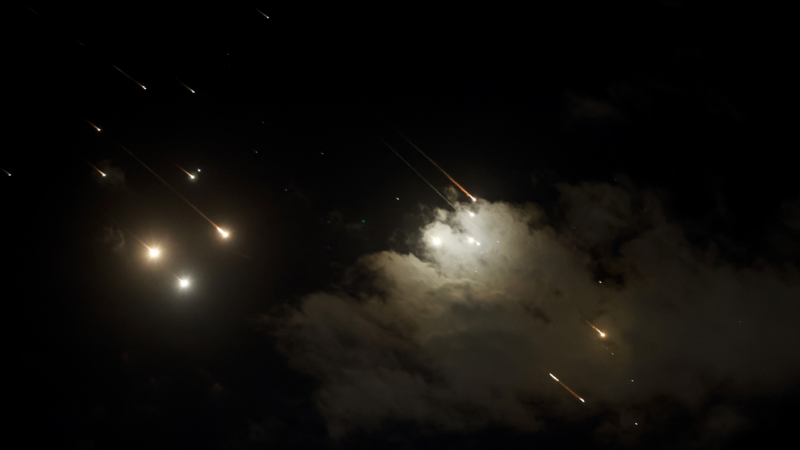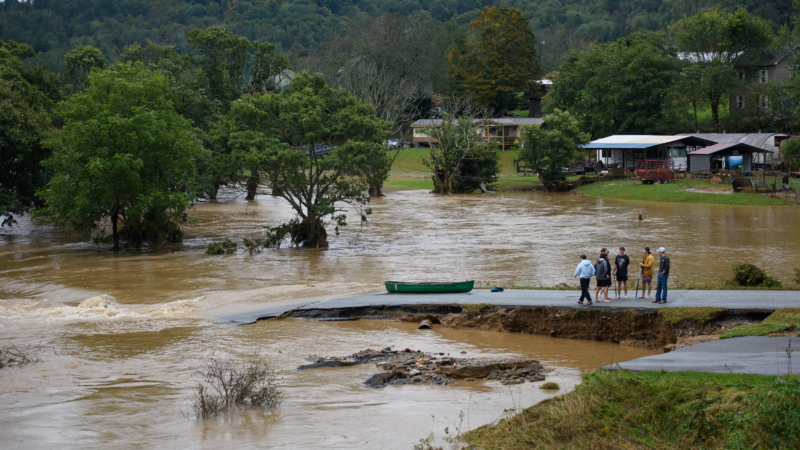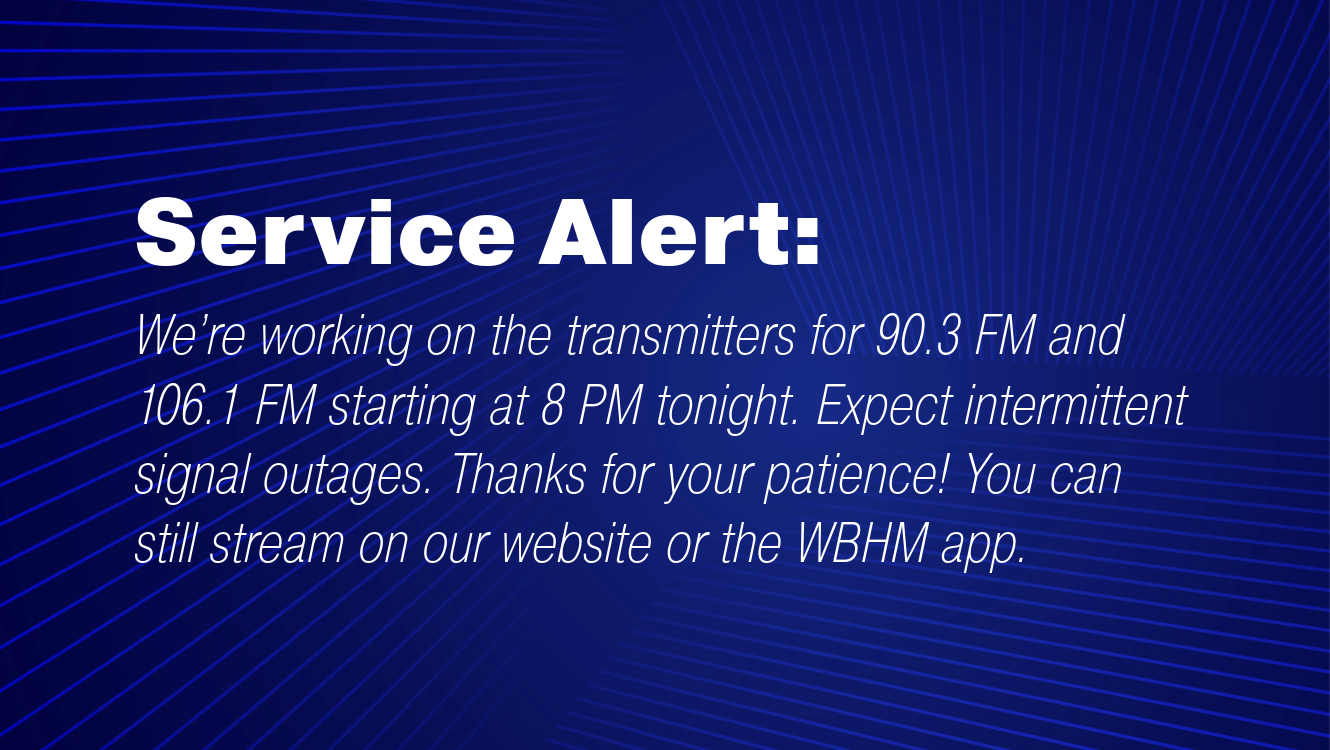How Iran’s missile strike on Israel appears to have hit some targets
Iran’s strike on Israel appears to have been more effective at reaching its targets than an attack in April of this year.
Videos posted to social media and geolocated by NPR and the online investigations group Bellingcat show multiple warheads landing around two Israeli air bases: Nevatim Airbase in the south of the country and Tel Nof Airbase in central Israel. One video filmed near Tel Nof also appeared to show possible secondary explosions, indicating that ammunition or fuel may have been struck by a missile.
Videos also showed warheads landing in northern Tel Aviv, near the headquarters of Israel’s intelligence agency, Mossad. Those warheads appear to have missed their target, and did not inflict any real damage. One video showed a large crater around 500 yards from the spy agency’s headquarters.
Experts say the attack was somewhat more successful than the one in April of this year, which was almost completely neutralized by Israeli and American air defenses.
“It looks like more missiles seem to be hitting targets in Israel this time around,” says Jeffrey Lewis, a professor at the Middlebury Institute of International Studies at Monterey. That could be in part because “the Iranians seem to be using newer, more sophisticated missiles.”
US Calls Strikes “Ineffective”
Both the U.S. and Israel downplayed the strikes. “This attack appears to have been defeated and ineffective,” National Security Advisor Jake Sullivan said in a briefing Tuesday. The U.S. said it had fired about a dozen interceptors from warships in an effort to blunt the Iranian assault.
Loading…
According to reports in the Israeli media, the military acknowledged that the strike had damaged “several” airbases. However it said that no aircraft had been destroyed. Israeli media reported that the attacks had mainly damaged maintenance areas and office buildings.
An Israel Defense Forces spokesperson declined to comment to NPR on casualties or damage resulting from the strike. The Israeli military spokesperson, Lt. Col. Peter Lerner, said in a briefing on the social media platform X that, “We don’t want to tip off Iran… Our air force and air force bases remain operational.”
Although the strike may have been limited in the damage it caused, it was a clear challenge to Israel’s much-vaunted air defense systems. Israel’s main system, called Iron Dome, has proven incredibly effective rockets from nearby adversaries like the militant groups Hamas and Hezbollah. Iron Dome uses relatively cheap interceptor missiles together with state-of-the-art radars and high-speed computing to quickly determine which incoming missiles pose a threat. It only takes shots at the ones it determines are falling in populated areas.
Better missiles and more of them
But ballistic missiles from Iran travel much higher and faster than those fired from nearby Lebanon and Gaza. The missiles fly briefly into space before coming down on their targets near or at hypersonic speeds. Israel has a separate missile defense system known as Arrow, which is capable of intercepting missiles near or in space, but Arrow has fewer interceptors than Iron Dome.

When Iran attacked Israel in April, it used around 100 ballistic missiles in conjunction with roughly 200 low flying drones and cruise missiles, according to Yehoshua Kalisky, a senior researcher at the Institute for National Strategic Studies in Tel Aviv, Israel. The drones and cruise missiles were shot down easily by fighter jets, leaving the missiles for Arrow, he says.
This time, Iran launched around 180 ballistic missiles, putting more strain on the Arrow system. “The job for the Arrow was much easier [in April],” he says.
Moreover, images of the missiles being fired out of Iran, together with pictures of debris that fell in Israel, suggests more sophisticated ballistic missiles were used, Lewis says.
In the April attack, Lewis says Iran used primarily liquid-fueled missiles that were relatively inaccurate. Half of the missiles fell more than a half mile from their targets. “It’s pretty hard to destroy something with that level of accuracy,” he says.
In this latest attack, Iran used new solid-propellant missiles that are more accurate, he says. Lewis and other researchers say at least some of the missiles used appear to be Iran’s newest design, the Fattah, a medium-range ballistic missile that may have a degree of maneuverability as it enters the atmosphere, allowing it to alter course and avoid interceptor missiles.
Lewis says he believes Iran’s latest strike was designed to show some restraint. The warheads fell primarily on air bases which may have been used in last week’s attacks on Hezbollah’s leadership, he points out. “It’s very typical to see Iranians pick military targets that are linked to the military strike that they’re responding to,” he says.
The strike also appeared to largely avoid civilian areas. The only publicly acknowledged death from the attack so far was a Palestinian man in the West Bank who was apparently struck by a falling missile body. A school in central Israel was also hit, though no casualties were reported.
Despite the attempt to control escalation, Israel is likely to respond with force, says Tom Karako, director of the Missile Defense Project at the Center for Strategic and International Studies. Following the April attack, Israel knocked out an air defense radar near Iran’s nuclear facilities in Natanz, he points out. That limited attack was designed to send a message: “The Israelis can penetrate Iranian airspace, they’ve demonstrated that time and time again,” he says. “They can bring the hurt to Iran.”
Israel’s military spokesperson Peter Lerner suggested that it would only be a matter of time before the nation struck back directly against Iran. “One ballistic missile is an unacceptable reality for any sovereign state,” he told reporters. “One hundred and eighty means there will be consequences.”
John Leguizamo went into ‘super sleuth dad’ mode to help his son learn Latino history
"America does not function without Latino immigrants," Leguizamo says. His new three-part PBS docuseries, VOCES American Historia, highlights Latino contributions to American history and culture.
Why Gov. Healey is taking action to immediately implement new gun law
Gov. Maura Healey is taking executive action to put the wide-ranging gun control law she signed this past summer into effect immediately Wednesday, preempting the possible suspension of the law by a 2026 referendum effort.
A court blocks a couple from suing Uber over a car crash because of Uber Eats’ terms
An appeals court sided with Uber, ruling a couple can't sue over a near-fatal car crash because they had agreed to Uber Eats' arbitration clause. Their lawyer is worried about a "slippery slope."
‘A terrible experience’: LGBTQ+ students face challenges amid Alabama’s Title IX, sports ban debate
Transgender students’ rights have come under increased scrutiny with a new school year underway as Alabama continues to push back against new Title IX rules.
This disabled woman built a career. A federal program that helped now penalizes her
Supplemental Security Income provides the medical care that lets people work. But its rules are complex and out of date.
Hurricanes contribute to thousands of deaths each year in the U.S.—many times the reported number
The death toll reported from an average tropical cyclone is 24. But the true toll is maybe 300 times higher—and the losses stretch for years after the storm passes.






